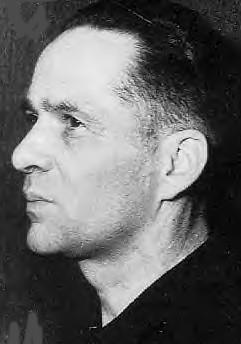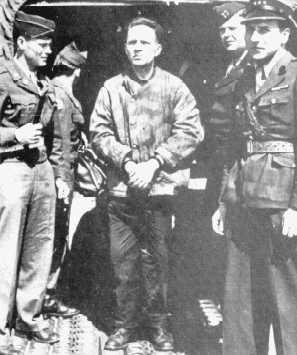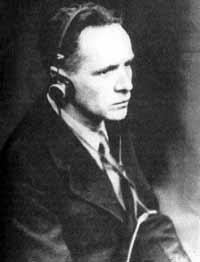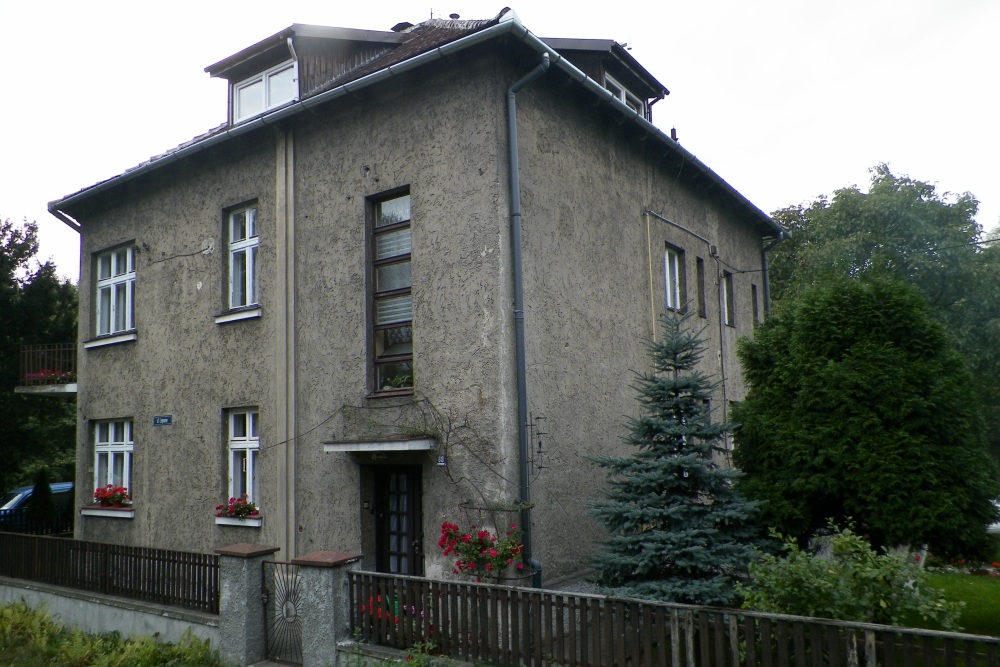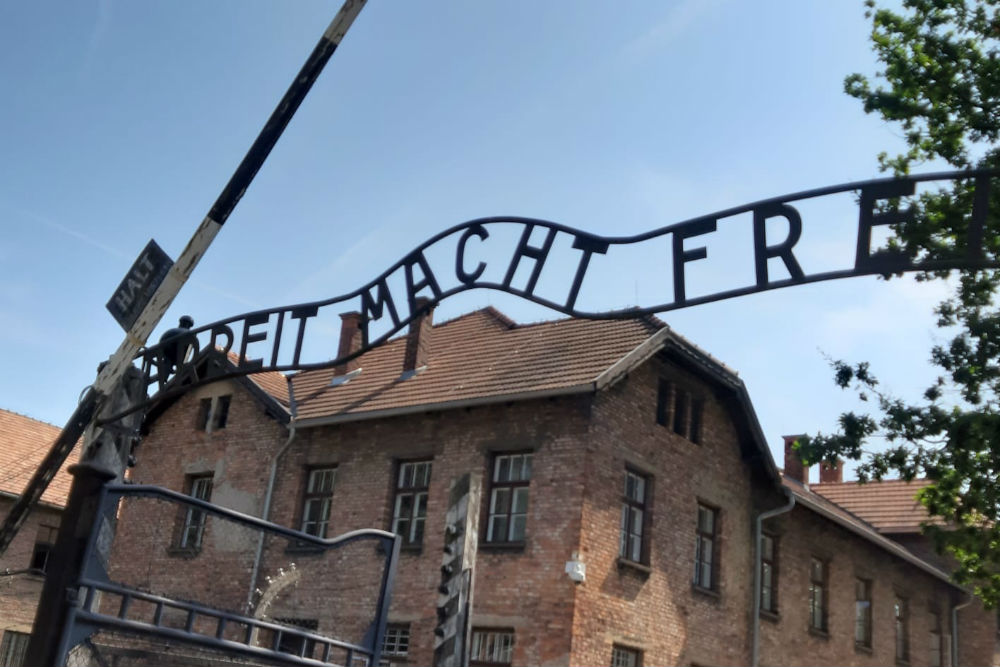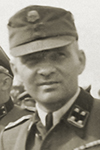>
Priest, soldier, assassin and peasant
Rudolph Höss was born November 25, 1900 in Baden-Baden, Baden-Württenberg. He was raised in the strictest Roman-Catholic sense and it was the dream of his father his son would become a priest. However, Rudolph lost his faith in the Church because a priest had broken his seal of confession. When World War One broke out, Höss voluntarily joined the German army. Here his preference for militarism, uniforms and discipline was evoked. Höss served in Turkey and during the violence of war in the trenches, he lost his fear of death. He was awarded the EK 1 and 2 for his courage during World War One.
Just like many other Germans, Höss lost his sense of direction somewhat after the war and was at odds what to do with his future. He joined the Freikorps in eastern Prussia and subsequently the Roßbach Freikorps in the Baltic states. He saw action in 1921 during the fighting against the Poles over Silesia and also, when the French occupied the Ruhr area from 1923 to 1925, he participated in violent actions against this occupation. In 1922, Höss joined the Nazis.
Together with Martin Bormann, Hitler’s future private secretary and four others, he murdered the teacher Walter Kadow in 1923 on the assumption he was spying for the Communists and collaborated with the French occupier of the Ruhr area. He was sentenced to ten years in prison for murder and political violence. As Höss had delivered the fatal blow with a small tree he had pulled out of the ground, his sentence was more severe than Bormann’s who got away with only one year for complicity. Höss was an exemplary inmate; he probably felt familiar with the strong discipline and the clear hierarchy in prison. He was released in 1928 for good conduct. After his tenure in custody, Höss wanted to focus on a romantic life in the country as a peasant and in 1928, he joined the Bund Artam, a Nazi grouping which propagated the Blut und Boden principle: resettlement of Germans on Polish soil to work in agriculture for instance.
From Dachau to Auschwitz
Höss had married in the meantime and together with his wife, he set himself up for the Voluntary Labor Service and recruited people for the various Nazi organizations, including the SS. Höss met Reichsführer-SS Heinrich Himmler and joined his organization, the SS in 1934. In December of that year he was engaged by concentration camp Dachau, which was commanded by Theodor Eicke. Höss was employed in the camp organization and gained experience in the daily operation of a concentration camp. The absolute discipline and obedience were self-evident to Höss and Eicke’s re-education program for harshness went very well with him. Soon, Höss evolved into a ruthless SS man who fully complied with the standards set by his tutor. Höss was able to function very well; whenever goals were set by others, he diligently went about his tasks.
From 1938 to 1940, Höss was employed in concentration camp Sachsenhausen in the rank of SS-Hauptsturmführer. In 1940, Himmler transferred him to Auschwitz, Oswiecim in Polish, where Himmler ordered him to convert an artillery barracks to an orderly concentration camp. The camp provided room for 10,000 Polish prisoners including Jews, resistance fighters, intellectuals, clergy men and politicians. In memory of his tutors, he had the slogan Arbeit macht Frei (Labor liberates) put up on all entries of the camp. Yet, it was not Höss’ intention to make Auschwitz into a second Dachau. The attitude towards Jews and other undesirable elements in Nazi society had changed in the meantime and this made Höss take a different attitude towards his inmates than his tutor Eicke did. To Eicke, prisoners were enemies of people and state but Höss took it a step further by branding his inmates as harmful elements within German society. Höss’ policy therefore was far more directed at elimination and the extermination of these harmful elements was exactly the goal Himmler had set for Auschwitz.
The policy Höss pursued in Auschwitz was centered around order, discipline and labor. The camp commander was a hard worker himself and was of the opinion any one in the camp had to do tough labor. Of course, inmates would work harder and under tougher conditions than camp guards did but no one in Auschwitz was to let time pass by doing nothing. An important slogan of Höss was ‘divide et impera’ or divide and rule, something he made clear in the way he divided power in his camp. Every one in Auschwitz had a certain place in the hierarchy and even certain groups of inmates had more rights than others and were deployed to guard the camp for instance. The first prisoners in Auschwitz had been transferred from concentration camp Sachsenhausen and were deployed in Auschwitz as guards or Kapo’s. They often treated their fellow inmates more cruelly than the SS guards did as they received special priviliges because of their work and maybe could even prolong their lives. Höss managed to introduce a cruel regime in Auschwitz where victims often would become perpetrators.
Höss was extremely obsessed by orderliness as is evident from the way he treated his SS guards. In Auschwitz, strict traffic rules applied for instance; the bicycles of the SS men had to be in pristine condition and many other nit-picking rules were introduced. While in the concentration camp, people struggled to survive in dismal circumstances, Höss considered it of great importance his SS men would not walk in the flower beds, which he formulated in the regulations as follows: "The freshly created gardens are the gems of the camp. For each SS man it must be a matter of course he leaves the gardens alone and does not walk in the flower beds."
In addition to orderliness and a spotless environment, Höss considered promoting togetherness among his guards also of great importance, just like his tutor Eicke did. In Auschwitz, sports competitions and theatre shows were held and the wives of the SS men also lived in the camp. By making the social and family lives of his guards seem as normal as possible, he camouflaged the terrible work they had to do and took care, his SS men began to consider their task as a normal job.
Endlösung
In the summer of 1941, Himmler ordered Höss to set up a new camp. This camp was constructed 2 miles from the original camp and was named Birkenau or Auschwitz II. Himmler wanted to use this camp for the Endlösung (final solution) of the Jewish question as he had been ordered to by Hitler. Hitler had selected Auschwitz because of the favorable rail and road connections and its isolated location. One of Himmler’s most important instruments of the Holocaust, Adolf Eichmann would soon brief Höss on the further details of this task but meanwhile it was obvious to Höss that the Endlösung was aimed at exterminating the entire Jewish race. This extermination had already begun on a relatively small scale, for instance in the various concentration camps and by the Einsatzgruppen, which carried out mass executions in the areas captured by the Germans of Jews and other enemies of the Nazis.
The task to convert Auschwitz I and II into mass extermination camps fitted diligent Höss like a glove. The main task for Höss and his fellow workers was to find a speedy and efficient way to kill large numbers of people. Mass executions were a severe mental burden for the SS men who made up the firing squads and gassing of people with carbon monoxide (CO) was not efficient when large numbers of people had to be gassed. Early September 1941, tests were carried out in Auschwitz with Zyklon-B (hydrogen cyanide, HCN), a substance that was previously used in the camps as desinfectant. These tests were extremely successful as 600 Soviet prisoners-of-war and 300 sick prisoners were killed with this substance. Höss was very pleased with this result, mainly because this substance was more humane for his guards. He abhorred blood baths and ruthless killing sprees and murdering with Zyklon-B prevented loss of blood.
Following the experiments with Zyklon-B in September 1941, the killing machine in Auschwitz swung into high gear. On January 20, 1942, the Wannsee Conference was held in Berlin. Various high ranking officials and SS men discussed the Endlösung. Meanwhile, Auschwitz II had been completely converted to an extermination camp and in April, Auschwitz I was being converted as well. September 1942 saw Höss promoted to SS-Obersturmbannführer and until well into November 1943, he supervised the murder of Jews from various countries.
Aktion Höss
Höss had been suffering from health problems for a long time and at the end of 1943, he exchanged Auschwitz for a quieter job in Berlin as head of Section D 1 of the W.V.H.A. (Wirtschafts- und Verwaltungshauptamt or Main Economic and Administrative Office). Within the SS, the W.V.H.A. was responsible for the central administration of the activities of the SS. Section D 1 was the office responsible for the organization of the concentration camps. In his capacity as inspector of concentration camps, he introduced Zyklon-B in numerous extermination camps and praised himself for this hygienic manner that made mass murder possible.
In the summer of 1944, Höss returned to Auschwitz by personal request of Himmler in order to organize the murder of one million Jews from Hungary. This operation was named Aktion Höss. He saw to the capacity of Auschwitz being increased and Höss completed this task in his habitual efficient manner as well and his superiors were very pleased with his achievements. The murder factory in Auschwitz remained operational until the camp was evacuated in January 1945 as Soviet troops were closing in; over 60,000 prisoners, escorted by their guards were evacuated on foot under deplorable conditions, countless died during these death marches. About 8,000 severely ill and exhausted prisoners who remained behind in Auschwitz were liberated by Soviet troops on January 27, 1945. Meanwhile Höss had left the camp and remained untraceable for the Allies for a long time.
Justice
An estimated 1,1 to 1,5 million people were murdered in Auschwitz including some 960,000 Jews. The exact number will never be known as an unknown number of Jews were gassed without any form of registration. In addition, a large part of the administration was deliberately destroyed by the leadership of the camp. After Europe had been liberated from Nazi Germany, no exact number of deaths from Auschwitz was known, Soviet estimates even ran into 4 million. It is obvious however that hundreds of thousands people were murdered in Auschwitz and that the employees of the camp and its commander should be brought to justice.
The one person responsible for the murders in Auschwitz was of course Rudolph Höss but he had disappeared prior to the liberation of the camp. He had taken a false identity as a farm hand and he was arrested as late as March 11, 1946 by British Military Police. After his arrest he was transferred to Nuremburg for questioning during the trial against the most important Nazis. He was interrogated as one of the key witnesses of the genocide in Auschwitz. In particular during the first days of April, he was interrogated extensively. Due to his late arrest, his testimony was not used by the court however as the tribunal had meanwhile finished its argumentation so new evidence could not be admitted any more. During this trial however, Höss was subpoenaed by Ernst Kaltenbrunner’s lawyer. Kaltenbrunner was the successor to Reinhard Heydrich as chief of the R.S.H.A. and Höss was to prove that Kaltenbrunner had had nothing to do with the genocide. As he had appeared as a witness, part of his testimony was included in the transcript of the trial but his statements were particularly important for the historic research into the mass murders in the Third Reich and the motivation and psychology of the perpetrators.
One of Höss’ interrogators was American psychologist Gustav Gilbert. Gilbert was highly fascinated by Höss and wanted to know in particular why a common man like him could evolve into one of the greatest assassins of the Third Reich. Höss’ simple explanation was that he had just done his job. He did not admit any guilt and considered his work in Auschwitz a matter of course. About his blind obedience to his superiors he said: "We SS men were not supposed to think about things; it did not even enter our minds. We considered it a matter of course that the Jews were blamed for everything." Höss also showed no pity whatsoever for his victims, he felt more pity for himself. He admitted he had not been happy any more once the mass extermination had begun. While his deputy was organizing the killing machine, Höss claimed he kept himself busy planning expansion projects. In order to erase the gruesome images, he frequently went horse back riding. Actually, it makes no difference whether or not Höss was bothered by the mass murders; he did everything he could to carry out the killing as efficiently and speedily as possible to keep his superiors happy. Survivors of Auschwitz describe Höss as a man who looked right through his victims, he hardly seemed to realize they were human beings. Owing to this attitude towards his prisoners, the gruesome events that unfolded under his command probably did not get through to him any more.
While awaiting his trial, Höss wrote an autobiography that was published as late as 1958. He did not live to see the publication of his book however as the Supreme Court in Warsaw sentenced him to death. On April 16, 1947, Höss was hung in Auschwitz. His life ended on the same location where under his command certainly over 1 million innocent people had been killed.
Definitielijst
- Blut und Boden
- “Blood and soil”. Term used by Adolf Hitler to describe the idea that people from German descent (German blood) had the right to live on German soil. Although not necessarily negative, the Nazis turned this idea into an ideology which they actually put into practice following the example of Walther Darré, head of the Rasse-und Siedlungs Hauptamt (RuSHA) (”Race-and Settlement bureau”).The Nazis also used this term to justify the extermination of the Jewish people.
- concentration camp
- Closed camp where people are being held captive that are considered to be anti- social, enemies of the state, criminal or unwanted individuals. These groups mostly do not get a fair trial or are condemned to doing time in a camp.
- Endlösung
- Euphemistic term for the final solution the Nazis had in store for the “Jewish problem”. Eventually the Endlösung would get the form of annihilating the entire Jewish people in extermination camps.
- Freikorps
- German paramilitary units established directly after the Great War by former front soldiers. These groups were often named after their commander. Freikorps formed the basis of the eventual SA or Sturmabteilung.
- Holocaust
- Term for the destruction of European Jewry by the Nazis. Holokauston is the Greek term for a completely burnt sacrifice.
- Jews
- Middle Eastern people with own religion that lived in Palestine. They distinguished themselves by their strong monotheism and the strict observance of the Law and tradition. During World War 2 the Jewish people were ruthlessly persecuted and annihilated by the German Nazis. . An estimated 6,000,000 Jews were exterminated.
- Kapo
- A Kapo was a prisoner in a concentration camp in Nazi Germany during World War 2 who was assigned to supervise other prisoners. A Kapo had to supervise the work of the prisoners and was responsible for their results on behalf of the SS.
- militarism
- Great influence of the army on civilian society.
- Nazi
- Abbreviation of a national socialist.
- resistance
- Resistance against the enemy. Often also with armed resources.
- Wannsee Conference
- Conference at the Wannsee on 20 January 1942. The Nazi’s made final agreements about the extermination of Jews in Europe, the Final Solution (Ëndlösung).
- Zyklon-B
- Poison gas that was systematically used in German extermination camps, primarily to murder Jews.
Images
Information
- Article by:
- Kevin Prenger
- Translated by:
- Arnold Palthe
- Published on:
- 19-01-2025
- Feedback?
- Send it!
Related sights
Sources
- KNOPP, G., Hitlers moordenaars, Het Spectrum, Utrecht, 2004.
- OVERY, R., De verhoren, De Bezige Bij, Amsterdam, 2002.
- READ, A., Discipelen van de duivel, Balans, Amsterdam, 2004.
- SPECTOR, S. & ROZETT, R., Encyclopedie van de Holocaust, Kok, Kampen, 2004.
-Axis Biographical Research
-Axis History
-Verzet.org
-www.dhm.de
-Shoa.de
